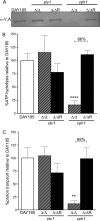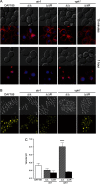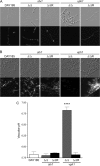Deletion of vacuolar proton-translocating ATPase V(o)a isoforms clarifies the role of vacuolar pH as a determinant of virulence-associated traits in Candida albicans
- PMID: 23316054
- PMCID: PMC3585055
- DOI: 10.1074/jbc.M112.426197
Deletion of vacuolar proton-translocating ATPase V(o)a isoforms clarifies the role of vacuolar pH as a determinant of virulence-associated traits in Candida albicans
Abstract
Vacuolar proton-translocating ATPase (V-ATPase) is a central regulator of cellular pH homeostasis, and inactivation of all V-ATPase function has been shown to prevent infectivity in Candida albicans. V-ATPase subunit a of the Vo domain (Voa) is present as two fungal isoforms: Stv1p (Golgi) and Vph1p (vacuole). To delineate the individual contribution of Stv1p and Vph1p to C. albicans physiology, we created stv1Δ/Δ and vph1Δ/Δ mutants and compared them to the corresponding reintegrant strains (stv1Δ/ΔR and vph1Δ/ΔR). V-ATPase activity, vacuolar physiology, and in vitro virulence-related phenotypes were unaffected in the stv1Δ/Δ mutant. The vph1Δ/Δ mutant exhibited defective V1Vo assembly and a 90% reduction in concanamycin A-sensitive ATPase activity and proton transport in purified vacuolar membranes, suggesting that the Vph1p isoform is essential for vacuolar V-ATPase activity in C. albicans. The vph1Δ/Δ cells also had abnormal endocytosis and vacuolar morphology and an alkalinized vacuolar lumen (pHvph1Δ/Δ = 6.8 versus pHvph1Δ/ΔR = 5.8) in both yeast cells and hyphae. Secreted protease and lipase activities were significantly reduced, and M199-induced filamentation was impaired in the vph1Δ/Δ mutant. However, the vph1Δ/Δ cells remained competent for filamentation induced by Spider media and YPD, 10% FCS, and biofilm formation and macrophage killing were unaffected in vitro. These studies suggest that different virulence mechanisms differentially rely on acidified vacuoles and that the loss of both vacuolar (Vph1p) and non-vacuolar (Stv1p) V-ATPase activity is necessary to affect in vitro virulence-related phenotypes. As a determinant of C. albicans pathogenesis, vacuolar pH alone may prove less critical than originally assumed.
Figures







Similar articles
-
Essential role for vacuolar acidification in Candida albicans virulence.J Biol Chem. 2013 Sep 6;288(36):26256-26264. doi: 10.1074/jbc.M113.494815. Epub 2013 Jul 24. J Biol Chem. 2013. PMID: 23884420 Free PMC article.
-
Candida albicans VMA3 is necessary for V-ATPase assembly and function and contributes to secretion and filamentation.Eukaryot Cell. 2013 Oct;12(10):1369-82. doi: 10.1128/EC.00118-13. Epub 2013 Aug 2. Eukaryot Cell. 2013. PMID: 23913543 Free PMC article.
-
The contribution of Candida albicans vacuolar ATPase subunit V₁B, encoded by VMA2, to stress response, autophagy, and virulence is independent of environmental pH.Eukaryot Cell. 2014 Sep;13(9):1207-21. doi: 10.1128/EC.00135-14. Epub 2014 Jul 18. Eukaryot Cell. 2014. PMID: 25038082 Free PMC article.
-
Beyond ergosterol: linking pH to antifungal mechanisms.Virulence. 2010 Nov-Dec;1(6):551-4. doi: 10.4161/viru.1.6.13802. Epub 2010 Nov 1. Virulence. 2010. PMID: 21178501 Review.
-
Vacuolar and plasma membrane proton-adenosinetriphosphatases.Physiol Rev. 1999 Apr;79(2):361-85. doi: 10.1152/physrev.1999.79.2.361. Physiol Rev. 1999. PMID: 10221984 Review.
Cited by
-
Promising Antifungal Targets Against Candida albicans Based on Ion Homeostasis.Front Cell Infect Microbiol. 2018 Sep 4;8:286. doi: 10.3389/fcimb.2018.00286. eCollection 2018. Front Cell Infect Microbiol. 2018. PMID: 30234023 Free PMC article. Review.
-
Impact of environmental conditions on the form and function of Candida albicans biofilms.Eukaryot Cell. 2013 Oct;12(10):1389-402. doi: 10.1128/EC.00127-13. Epub 2013 Aug 16. Eukaryot Cell. 2013. PMID: 23954841 Free PMC article.
-
Quinacrine inhibits Candida albicans growth and filamentation at neutral pH.Antimicrob Agents Chemother. 2014 Dec;58(12):7501-9. doi: 10.1128/AAC.03083-14. Epub 2014 Oct 6. Antimicrob Agents Chemother. 2014. PMID: 25288082 Free PMC article.
-
In Vivo Indicators of Cytoplasmic, Vacuolar, and Extracellular pH Using pHluorin2 in Candida albicans.mSphere. 2017 Jul 5;2(4):e00276-17. doi: 10.1128/mSphere.00276-17. eCollection 2017 Jul-Aug. mSphere. 2017. PMID: 28685162 Free PMC article.
-
Candida Biofilms: Development, Architecture, and Resistance.Microbiol Spectr. 2015 Aug;3(4):10.1128/microbiolspec.MB-0020-2015. doi: 10.1128/microbiolspec.MB-0020-2015. Microbiol Spectr. 2015. PMID: 26350306 Free PMC article. Review.
References
-
- Manolson M. F., Proteau D., Jones E. W. (1992) Evidence for a conserved 95–120-kDa subunit associated with and essential for activity of V-ATPases. J. Exp. Biol. 172, 105–112 - PubMed
-
- Manolson M. F., Proteau D., Preston R. A., Stenbit A., Roberts B. T., Hoyt M. A., Preuss D., Mulholland J., Botstein D., Jones E. W. (1992) The VPH1 gene encodes a 95-kDa integral membrane polypeptide required for in vivo assembly and activity of the yeast vacuolar H+-ATPase. J. Biol. Chem. 267, 14294–14303 - PubMed
Publication types
MeSH terms
Substances
Grants and funding
LinkOut - more resources
Full Text Sources
Other Literature Sources
Molecular Biology Databases
Research Materials

